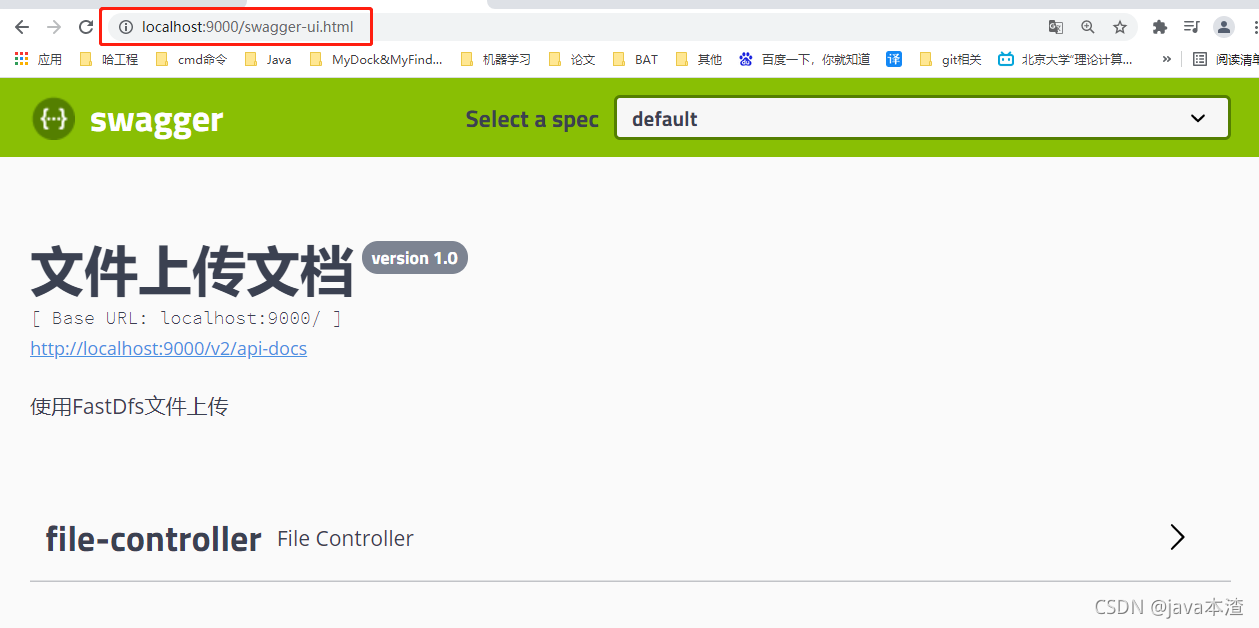1. Swagger的概念
Swagger是一款目前世界最流行的API管理工具。目前Swagger已经形成一个生态圈,能够管理API的整个生命周期,从设计、文档到测试与部署。
尤其擅长管理基于Restful的WebService接口。
Swagger有几个重要特性:
- 代码侵入式注解
- 遵循YAML文档格式
- 非常适合三端(PC、iOS及Android)的API管理,尤其适合前后端完全分离的架构模式
- 减少没有必要的文档,符合敏捷开发理念
- 功能强大
2. Swagger的作用
接口的文档在线自动生成

功能测试

3. Swagger的优势
- 大大减少前后端的沟通
- 方便查找和测试接口
- 提高团队的开发效率
- 方便新人了解项目
4. Swagger的使用
4.1 引入依赖
<dependency>
<groupId>io.springfox</groupId>
<artifactId>springfox-swagger2</artifactId>
<version>2.9.2</version>
</dependency>
<dependency>
<groupId>io.springfox</groupId>
<artifactId>springfox-swagger-ui</artifactId>
<version>2.9.2</version>
</dependency>
4.2 编写Swagger配置类
@Configuration
@EnableSwagger2//开启Swagger2
public class SwaggerConfig {
@Bean
public Docket createRestApi() {
return new Docket(DocumentationType.SWAGGER_2)
.apiInfo(apiInfo())
.select()
.apis(RequestHandlerSelectors.basePackage("com.lijinghua")) //swagger搜索的包
.paths(PathSelectors.any()) //swagger路径匹配
.build();
}
//api文档信息
private ApiInfo apiInfo() {
return new ApiInfoBuilder()
.title("文件上传文档")//文档标题
.description("使用FastDfs文件上传")//文档说明
.version("version 1.0")//版本信息
.build();
}
}
4.3 测试

5.Swagger常用注解
我们可以通过Swagger注解,侵入式地、更详细地、具体地对API进行说明。
5.1 测试代码
5.1.1 UserController类
@RestController
@RequestMapping("/user")
@Api(tags = {"用户管理API"})
public class UserController {
@PostMapping
@ApiOperation(value = "新增用户", notes = "新增后返回当前用户")
@ApiResponses({
@ApiResponse(code = 200, message = "返回成功", response = User.class),
@ApiResponse(code = 400, message = "参数没有填好(id==1)", response = User.class),
@ApiResponse(code = 401, message = "权限不足(id==1)", response = User.class),
})
public ResponseEntity<User> add(User user) {
if (user.getId() == 1) {
return new ResponseEntity<>(user, HttpStatus.BAD_REQUEST); //400
} else if (user.getId() == 2) {
return new ResponseEntity<>(user, HttpStatus.UNAUTHORIZED); //401
} else {
return ResponseEntity.ok(user);
}
}
@PutMapping
@ApiOperation(value = "修改用户", notes = "修改后返回当前用户")
@ApiResponses({
@ApiResponse(code = 200, message = "返回成功", response = User.class),
@ApiResponse(code = 400, message = "参数没有填好(id==1)", response = User.class),
@ApiResponse(code = 401, message = "权限不足(id==1)", response = User.class),
})
public ResponseEntity<User> update(User user) {
if (user.getId() == 1) {
return new ResponseEntity<>(user, HttpStatus.BAD_REQUEST); //400
} else if (user.getId() == 2) {
return new ResponseEntity<>(user, HttpStatus.UNAUTHORIZED); //401
} else {
return ResponseEntity.ok(user);
}
}
@DeleteMapping("/{id}")
@ApiOperation(value = "删除用户", notes = "删除后返回当前id")
@ApiResponses({
@ApiResponse(code = 200, message = "返回成功", response = User.class),
@ApiResponse(code = 400, message = "参数没有填好(id==1)", response = User.class),
@ApiResponse(code = 401, message = "权限不足(id==1)", response = User.class),
})
@ApiImplicitParam(paramType = "path", name = "id", value = "用户主键ID", required = true)
public ResponseEntity<Long> delete(@PathVariable Long id) {
if (id == 1) {
return new ResponseEntity<>(id, HttpStatus.BAD_REQUEST); //400
} else if (id == 2) {
return new ResponseEntity<>(id, HttpStatus.UNAUTHORIZED); //401
} else {
return ResponseEntity.ok(id);
}
}
@GetMapping("/{id}")
@ApiIgnore
public ResponseEntity<Long> toUpdate(@PathVariable Long id) {
if (id == 1) {
return new ResponseEntity<>(id, HttpStatus.BAD_REQUEST); //400
} else if (id == 2) {
return new ResponseEntity<>(id, HttpStatus.UNAUTHORIZED); //401
} else {
return ResponseEntity.ok(id);
}
}
@PostMapping("/list-page")
@ApiOperation(value = "分页查询", notes = "得到分页查询对象pageInfo")
@ApiImplicitParams({
@ApiImplicitParam(paramType = "query", name = "pageNum", value = "当前页", required = false, defaultValue = "1"),
@ApiImplicitParam(paramType = "query", name = "pageSize", value = "每页行数", required = false, defaultValue = "10")
})
public ResponseEntity<String> findByPage(@RequestParam(defaultValue = "1", required = false)
Integer pageNum, @RequestParam(defaultValue = "10", required = false) Integer pageSize) {
return ResponseEntity.ok("find page result...");
}
}
5.1.2 User实体类
@Data
@ApiModel("用户对象模型")
public class User {
private Long id;
private String username;
private String password;
private String email;
}
5.2 @Api()
用在请求的类上,表示对类的说明,也代表了这个类是swagger2的资源。它有几个参数:
- tags:说明该类的作用,参数是个数组,可以填多个。
- value:该参数没什么意义,在UI界面上不显示,所以不用配置。
- description : 用户基本信息操作(已被废弃)。


5.3 @ApiOperation()
用于方法,表示一个http请求访问该方法的操作。它有几个参数:
value:方法的用途和作用。
notes:方法的注意事项和备注。
tags:说明该方法的作用,参数是个数组,可以填多个。
格式:tags={“作用1”,“作用2”},(在这里建议不使用这个参数,会使界面看上去有点乱,前两个常用)。


5.4 @ApiModel()
用于响应实体类上,用于说明实体作用。参数:
- description:描述实体的作用。


5.5 @ApiModelProperty()
用在属性上,描述实体类的属性。它有几个参数:
- value:描述参数的意义。
- name:参数的变量名。
- required:参数是否必选。


5.6 @ApiImplicitParams()
用在请求的方法上,包含多@ApiImplicitParam。
5.7 @ApiImplicitParam()
用于方法,表示单独的请求参数,它有几个参数:
- name:参数名。
- value:参数说明。
- dataType:参数的数据类型。
- paramType:表示参数放在哪里。
- header 请求参数的获取:@RequestHeader
- query 请求参数的获取:@RequestParam
- path(用于restful接口) 请求参数的获取:@PathVariable
- body(不常用)
- form(不常用)
- defaultValue:参数的默认值。
- required:表示参数是否必须传。


5.8 @ApiParam()
与@ApiImplicitParam()作用基本相同,但是功能较弱,用于方法、参数,它有几个参数:
- name:参数名。
- value:参数说明。
- defaultValue:参数的默认值。
- required:表示参数是否必须传。
5.9 @ApiResponses
用于请求的方法上,根据响应码表示不同响应,一个@ApiResponses包含多个@ApiResponse。
5.10 @ApiResponse
用在请求的方法上,表示不同的响应,它有几个参数:
- code:表示响应码(int型),可自定义。
- message:状态码对应的响应信息。


5.11 @ApiIgnore()
用于类或者方法上,不被显示在页面上。


版权声明:本文为weixin_44010763原创文章,遵循CC 4.0 BY-SA版权协议,转载请附上原文出处链接和本声明。